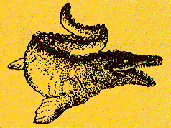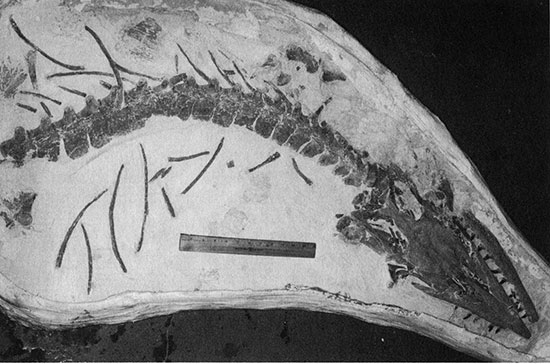
Kansas Geological Survey, Educational Series 6, originally published in 1988
Previous Page--Rocks and Minerals ||
Next Page--Landforms and Landscapes
Over millions of years Kansas has been home to a variety of plants and animals. As the climate changed, different types of plants and animals moved in and out. Elephants, camels, tigers, large flying and swimming reptiles, sharks, 20-foot fish, and even three types of dinosaurs have all lived in Kansas at one time or another. Some descendants of these animals have survived and now live in other parts of the world. Others, such as the dinosaur, have become extinct. There are no dinosaurs today anywhere in the world.
Figure 23. The drawing shows what crinoids in the ancient Kansas sea looked like. The crinoid fossil was found in limestone, millions of years after the animal died and was fossilized.

We would never have known which animals had lived in Kansas if there were no fossils. Fossils are the remains of plants or animals that have been preserved in rock. Body parts, especially bones and teeth, may be preserved. Impressions or outlines of plants and animals are also found in some rocks. Sometimes the only evidence of an early animal is a footprint or track that has become hardened in rock. All of these--bones, teeth, impressions, outlines, footprints, and tracks--are fossils.
Fossils help geologists learn about the Earth. Another scientist, the paleontologist, specializes in studying fossils and life in the past. Both geologists and paleontologists explore the Earth's surface and subsurface to learn more about its history.
Through fossil finds, paleontologists can piece together evidence of earlier life and landscapes. On one expedition in 1885, a footprint was found in a subsurface sandstone dug from a well in Ellsworth County. The sandstone was formed from sand deposited during the Cretaceous Period. Because of the position of the toes, scientists decided the impression was probably made by a bird.
Not far from where the footprint was found, impressions of leaves were found in the same layer of sandstone. The leaves came from trees similar to modern-day oaks, willows, poplars, laurels, sarsaparillas, magnolias, and sassafras trees. None of these trees is native to Ellsworth County today, although people have planted some of them in the area. They grow naturally in other areas of the world where the temperatures are warmer. In the same sandstone surrounding the area where the leaves were found, fossils of marine fish and seashells were found.
Figure 24. A fossil leaf found in Dakota Sandstone, which was deposited about 100 million years ago in Ellsworth County.

By putting all of these fossil finds together, we know that a sea covered Ellsworth County millions of years ago. In this sea was at least one small island that was covered with beautiful trees and inhabited by birds. Insects also lived on the island because the leaves showed signs of insect attacks. The types of trees that were able to grow indicate the climate was probably warmer and wetter than it is today.
Before and after 1885, many other fossils have been discovered in Kansas and throughout the world. By studying fossils and rocks, scientists are able to determine what plants and animals lived during different periods and what their environments were like.
Figure 25. This fossil was formed from a starfish that lived about 300 million years ago in the Pennsylvanian Period.

Fossils form only under certain conditions. Very few plants and animals are fossilized. Dead plants and animals must be buried quickly and not exposed to harsh weather and running water. Deltas, marshes, swamps, and shallow seas are ideal places for fossils to form. Because Kansas has been covered with marshes and seas several times in the past, it has a good supply of fossils.
The most common Kansas fossils are marine animals found in rocks formed in the Pennsylvanian, Permian, and Cretaceous periods. Few fossils of plants and animals that lived before the Mississippian Period have been found in Kansas. As the rocks changed over time, many of the fossils were destroyed. Also, many early animals had soft bodies. Most animal parts that are preserved are hard, such as bones, teeth, and shells.
Figure 26. A clam-shell fossil from the Pennsylvanian Period.

But the main reason for few early fossil finds in Kansas is that no rocks formed before the Mississippian Period are found at the surface in Kansas. Fossils of tiny single-celled plants and animals from earlier periods have been found in rocks brought up from hundreds, even thousands, of feet underground when oil and water wells were drilled. The chance of finding larger fossils by this method is not good because the rock brought up from underground during drilling is usually crushed into small pieces. Also, only a narrow cylinder of rock-about two to four inches in diameter-is ever removed from the hole. Much of what we know about life before the Mississippian Period comes from fossils found in areas outside of Kansas.
Figure 27. Brachiopods, small-shelled marine animals, were abundant in Kansas seas more than 250 million years ago.

Nonmarine plant and animal fossils also have been found in Kansas, but they are not as common because plants and animals often decay on dry land before they can be fossilized. Usually only fragments of bones or teeth are fossilized, and only a small number survive over millions of years.
Paleontologists compare new fossil finds to other fossils and to living animals. This helps them determine what animals looked like millions of years ago.
A variety of marine-animal fossils have been found in Kansas, including corals, bryozoans, brachiopods, crinoids, clams, snails, squid, jellyfish, trilobites, eurypterids, turtles, fish, and sharks. You may not be familiar with some of these animals even though many of them have living relatives. Numerous sea plants and animals today are rarely seen because they spend their lives crawling on or attached to the ocean floor.
Like their descendants, Kansas corals, bryozoans, and crinoids attached themselves to the sea floor or each other and rarely moved. Although they look more like plants, all of these are really animals. Shelled animals, such as brachiopods, clams, and snails also spent their lives deep underwater on the floors of the Kansas seas.

Besides stationary animals, the ancient Kansas seas also had active crawlers and swimmers. Trilobites were present in the Pennsylvanian seas in eastern Kansas. Several types existed at one time, but they are now all extinct. Another extinct sea dweller, the eurypterid, grew up to six feet long in the Kansas seas. Its living relative, the horseshoe crab, can still be found in many parts of the world today.
Several types of sharks and fish lived in the Pennsylvanian and Permian seas. An even greater variety of fish fossils have been found in rocks formed in the later Cretaceous sea that covered western Kansas. These fish shared the sea with the bottom dwellers and large swimming reptiles.
Two types of swimming reptiles, the mosasaur and the plesiosaur, have been found in Cretaceous sea deposits. From the looks of their large fossilized skeletons, they must have been a frightening and probably unwelcome sight to their smaller neighbors. Both reptiles had long bodies, sharp teeth, and paddlelike limbs. Although mosasaurs and plesiosaurs are extinct today, many of their smaller relatives, including snakes and lizards, are still common.
Figure 28. Mosasaurs, giant swimming reptiles, were up to 20 feet long. This mosasaur fossil, which includes the head and part of the spine and ribs, was found in western Kansas.

No evidence of land-dwelling animals on earth before the Devonian Period--410 million years ago--has been found. Plants showed up on land a little earlier in the Silurian Period. Before this period, all known life lived in the water. Before and after land dwellers appeared, millions of species of plants and animals lived on the Earth. Some are extinct, but many are still around today.
Among the extinct animals are a number of giant reptiles, including the dinosaurs. Fossil evidence suggests that dinosaurs appeared during the Mesozoic Era and disappeared at the end of that era.
No one is certain what caused the extinction of the dinosaurs, other giant reptiles, and many plant and animal species. Many scientists now believe the Earth's climate changed drastically. The change may have been caused by a meteor shower where millions of rocks and other debris from outer space collided with the Earth. Why some species were able to endure while others, such as dinosaurs, became extinct is not yet known.
Not many dinosaur fossils have been found in Kansas. During the early Mesozoic Era, erosion was fairly common in Kansas so not many animals or plants could be preserved as fossils. In the last part of the Mesozoic Era, the Cretaceous seas covered much of the state and most animals were of the marine variety. However, three types of dinosaurs did live along the Kansas shoreline. Fossils of Sylvisaurus, Heirosaurus, and Claosaurus have been discovered.
Sylvisaurus and Heirosaurus were armored dinosaurs. The Sylvisaurus grew to 10 feet in length and the Heirosaurus to 20 feet. The Claosaurus stood on its hind legs, grew up to 12 feet in height, and had a duck bill. Like many dinosaurs, the Sylvisaurus, Heirosaurus, and Claosaurus were herbivores, or plant eaters.
Another unusual reptile, the pterosaur, dominated the Kansas skies during the Mesozoic Era. Although the pterosaur could fly, it probably had hair rather than feathers on its wings. Fossils of pterosaurs found in Kansas have wingspans under 20 feet, but larger pterosaurs have been found in other places.
The plants and animals that were able to survive into the Cenozoic Era often are more familiar to us. Thousands of fossils of plants, insects, amphibians, reptiles, birds, fish, and mammals have been found in Cenozoic rocks in Kansas.
During the Cenozoic Era, large mammals began to appear. Mammals such as the mastodon, woolly mammoth (ancestor of the elephant), rhinoceros, camel, tiger, peccary (wild pig), and bison roamed through Kansas in the early part of the era. By the time people began making Kansas their home, many of these animals were extinct or had migrated to other parts of the world. The bison, one of the few large animals that did survive, almost became extinct when thousands were slaughtered by hunters in the 1800's. Even though an assortment of wild animals still live in Kansas, most seem tiny compared to the giant mastodons and mammoths.
Figure 29. This diagram shows the size (in feet) of several animals that lived in Kansas at one time or another. Dimetrodon fossils have been found in Permian rock. Mosasaurs and pterosaurs lived in western Kansas during the Cretaceous. The Teleoceras, a rhinoceros, lived in Kansas in the Tertiary Period, and mammoths traveled in herds on the plains during the early Quaternary Period.

Previous Page--Rocks and Minerals || Next Page--Landforms and Landscapes
Kansas Geological Survey
Placed on web Feb 11, 2016; originally published 1988, reprinted 1995.
Comments to webadmin@kgs.ku.edu
The URL for this page is http://www.kgs.ku.edu/Publications/Bulletins/ED4/03_fossils.html